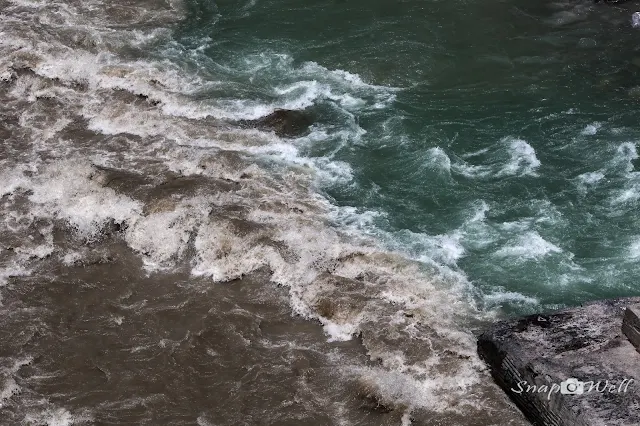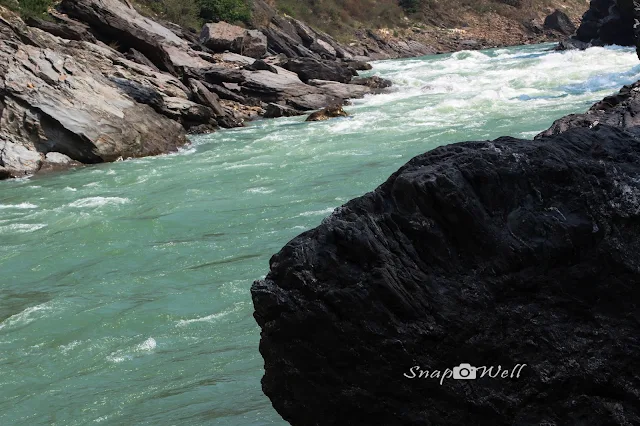From Pandukeshwar heading back to Rishikesh, we stopped at Vishnu Prayag. Before I describe about Vishnu Prayag I would like to explain few things I learned from local people about Prayag in Uttarakhand. Before this, I used to think Prayag is another name for the famous city of Allahabad in Uttar Pradesh. It is after visiting Uttarakhand I learnt, Prayag is a place of confluence or merging of two or more rivers. It actually means a place of Sacrifice in Sanskrit. At these points, when two rivers meet, one of the rivers sacrifices its name and identity to the other. There are five such prayags in Uttarakhand, the land of Gods as they say and I don't think any other states in India has these many Prayags.
Rivers Dhauliganga, Nandakini, Pindari, Saraswati merge with Alaknanda and Sacrifices the name and their identities at Vishnu Prayag, Nand Prayag, Karna Prayag, RudraPrayag respectively and Alaknanda sacrifices its name and identity at Dev Prayag on merging with river Bhagirathi giving birth to Ganga, the mother of all rivers in India.
Let us now explore about these Prayags individually in detail:
Vishnu Prayag:
Vishnu Prayag is the merging point of river Alaknanda and Dhauliganga. Alaknanda river which originates at Satopanth glaciers and flows through Badrinath. Dhaluiganga originates at Niti pass and travels 25 kilometers to merge with Alaknanda at Vishnu Prayag. According to the Legend sage Narada worshiped here to please Lord Vishnu, hence the name Vishnu Prayag.
We spent lot of time here enjoying and witnessing the blissful union of two exhilarating rivers. I witnessed the Prayag of Ganga, Yamuna and Saraswati at Allahabad earlier. Though you can identify the water of Ganga and Yamuna at Allahabad but here at Vishnu Prayag the waters can be distinctly identified. It's a rare sight to watch.
Now I will take you to the image of Alaknanda river flowing from one side of the mount.
I am in love with the purity and especially the color of the water in Alaknanda river. It is dancing down the rocks with white bubbles to unite with Dhauliganga.
This is Dhauliganga on the other side of the mount flowing with equal vibrancy and enthusiasm to meet Alaknanda.
I don't know exactly but my guess is that it is named Dhauliganga because of its water that is muddy as mud is called dhool in hindi. Please let me know if anyone knows so that I can correct it.
Dhauliganga river passes through some huge rocks. The flow of dhauliganga is very intense.
There are some beautiful giant rocks towards this side.
This is Alaknanda from one side.
And Dhauli Ganga from the other side.
Here is the image of this blissful union of Alaknanda and Dhauliganga. The river with blue waters is Alaknanda and muddy water is the Dhauliganga.
See how distinctly the water is seen at the Prayag. Amazing! Isn't it?
Look how the river water is bubbling with joy on union. Awesome view!
Look at those tides. They are not due to the collision of rocks but with the force of two rivers meeting.
Here are some magnificent closeup shots of Vishnu Prayag.
It is difficult to understand whether the rivers are showing their strength or their warmth.
Whatever it may be, it is a delight to watch.
You can see that in the picture below. This was shot with a 300 mm lens. You can see the waters travelling distinctly separate for some distance even after uniting.
This is of a village lady carrying grass on her back. This must be for her cattle I guess. She gave a beautiful smile with blush on her face when I clicked the photo. Thank you beautiful lady.
Nand Prayag:
Nand Prayag is the second in sequence of Prayags where river Alaknanda merges with Nandakini River. We just stopped here but haven't spent much time as we were getting late for the next destination to Karn Prayag where we decided to halt for the day. Therefore I do not have much information about this.
Karna Prayag:
Karn Prayag is the place where Alaknanda river merges with Pindari river that originates from the Pindar glacier below Nandadevi mountain range. As per the Legend of Mahabharata, Karna did penance and earned the protective gear of Kavacha (Armour) and Kundali (ear rings) from his father, the Sun God. Hence the confluence is named after Karna.
It rained heavily in the surrounding villages and was drizzling slightly at Karna Prayag when we reached there. As a result of this water appeared muddy and lost the real color of Alaknanda due to flood waters.
But we can still distinguish the waters. The dark water is of Pindari and other is of Alaknanda.
We took shelter at Baba Kali Kamli math for that night and started our journey early morning the next day to Rudra Prayag.
Rudra Prayag:
At Rudra Prayag Alaknanda river meets the river Mandakini. Lord Shiva is also known as Rudra. According to a widely narrated legend, it is said that Rudra did a Tandav here. Tandav is a vigorous dance that is the source of the cycle of creation, preservation and dissolution. Hence the name Rudra Prayag.
I was actually surprised to see the color of Mandakini waters. It was so blue and pure at the place of Origin. Due to heavy rains again both Alaknanda and Mandakini appeared muddy.
On asking the locals they said, there was a heavy rainfall the day before we arrived. Otherwise the both waters will be clear blue in color.
On asking how come the water levels so low if rained heavily? They said, there is a dam somewhere and they regulate the flow of waters.
With a short stay here we headed to Dev Prayag.
Dev Prayag:
Dev Prayag is the confluence of two holy rivers, the Bhagirathi - the chief stream of Ganga and Alaknanda. Beyond this confluence, the river is known as Ganga. It is the first Prayag on the way to Badrinath. The holiness of this confluence is said to be equal to the Triveni Sangam of Allahabad. As per the legend, a poor Brahman called Deva Sharma performed rigorous religious austerities here and was blessed by Lord Rama. Hence the sangam is named Dev Prayag after his name.
We spent good amount of time here at this Prayag. The waters of Bhagirarthi and Alaknanda are clear and distinct.
I clicked some wonderful images of Bhagirathi.
This is another view of Bhagirathi. Look at the vehicles passing over and across the bridge. Due to equal importance of Dev Prayag with Triveni Sangam of Allahabad it is visited by many.
One of the distinct features of Bhagirathi river is the flow. It flows at a great speed and the same speed is visible at Triveni sangam at Allahabad.
Here also you find some beautiful rock formations in and around the river.
Look at the rock below. Doesn't it look like the head of some being spitting water from the mouth?
Look at the beautiful rock formation on the left of the image below.
We spent lot of time on these rocks here.
Ganga carries this color, probably green to few miles from here and turns military green on reaching Vasisht Ashram.By Rishikesh it turns Bronze yellow - a shade with a mixture of yellow and green. It appears straw yellow - a shade of yellow and grey at Haridwar.
On the other side Alaknanda river flowing through great intensity.
Here comes the confluence of two mighty rivers Alaknanda and Bhagirathi.
Both Bhagirathi and Alaknanda loses their name and identity giving birth to river Ganga.
It is only from this point after five Prayags river Ganga is born.
Ganga is the largest river of India that originates from the western Himalayas in the state of Uttarakhand and empties itself into the sea after travelling a mammoth distance of 2,525 kilometers crossing Bangladesh in the East.
It is the third largest river in the World and is flowing from the time immemorial.
From here we headed to Rishikesh and from there to Haridwar to end the journey of Uttarakhand we headed back to Hyderabad. I gave the description of Haridwar in my initial updates.
There is one more update left from the trip to Uttarakhand after this. I got tremendous response from the readers to all my updates on Uttarakhand. I really thank and appreciate the followers and readers of this blog for the patience. Thanks again. Keep watching the space for more updates.

















































Comments
Post a Comment